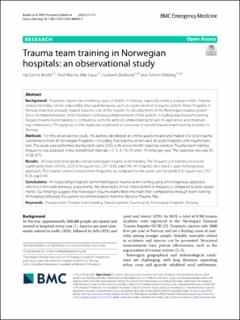| dc.description.abstract | Background
Traumatic injuries are a leading cause of deaths in Norway, especially among younger males. Trauma-related mortality can be reduced by structural measures, such as organization of a trauma system. Many hospitals in Norway treat few seriously injured patients, one of the reasons for development of the Norwegian trauma system. Since its implementation, there has been continuous improvement of this system, including trauma team training. Regular trauma team training is compulsory, with the aims of compensating for lack of experience and maintaining competence. The purpose of this study was to present an overview of current trauma team training activities in Norway.
Methods
For this observational study, the authors developed an online questionnaire and mailed it to local trauma coordinators from 38 Norwegian hospitals—including four trauma centers and 34 acute hospitals with trauma function. The study was performed during April–June 2020, with a two-month response window. Trauma team training frequency was assessed in four predefined intervals: < 5, 5–9, 10–15 and > 15 times per year. The response rate was 33 of 38, 87%.
Results
All responding hospitals conducted regular trauma team training. The frequency of training increased significantly from 2013 to 2020 (Chi square test, Chi2 8.33, p = 0.04). All hospitals described a quite homogenous approach. The trauma centres trained more frequently as compared to the acute care hospitals (Chi square test, Chi2 8.24, p = 0.04).
Conclusions
All responding hospitals performed regular trauma team training using a homogenous approach, which is in line with previous assessments. We observed a minor improvement in frequency compared to prior assessments. Our findings suggest that Norwegian trauma teams likely maintain their competence through team training. All hospitals followed the current recommendations from the National Trauma Plan. | en_US |

